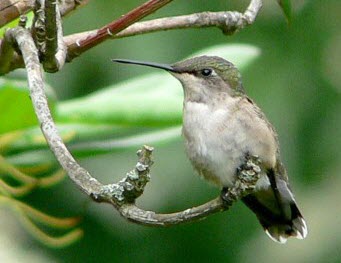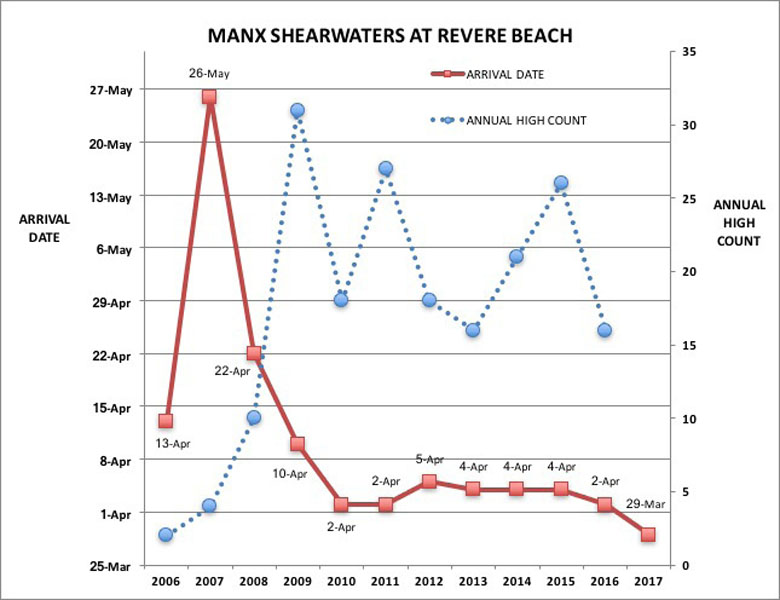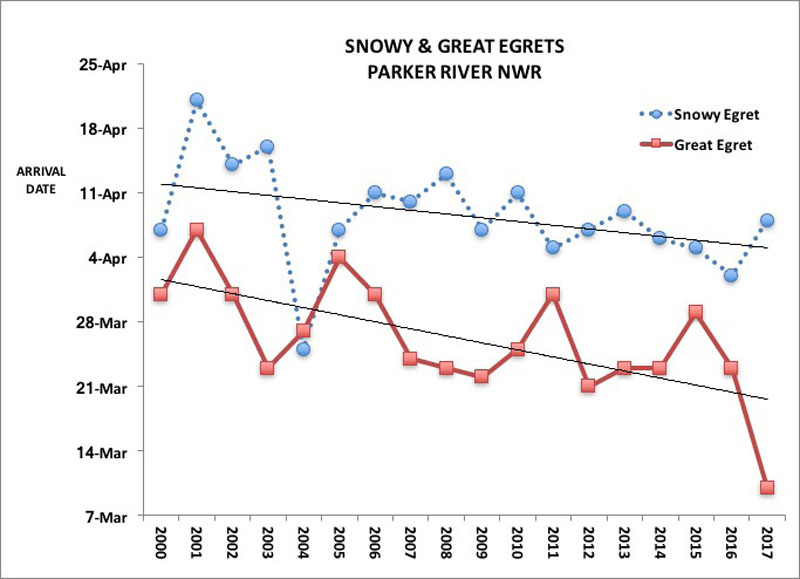Neil Hayward and Robert H. Stymeist

Ruby-throated Hummingbird by Richard Johnson
March arrived like a lamb with a high of 63°, the highest temperature recorded for the month, but it quickly dropped to a low of 21° on March 4. The average for March was 34°, four degrees below the norm. Rainfall in Boston totaled 4.18 inches, just a tad under normal with the most falling during the nor’easter on March 13–14. Snowfall totaled 10.1 inches in Boston, most of which fell in two back-to-back storms on March 10 and 13–14. The powerful nor’easter on March 13–14 buried Worcester and much of the area north and west of Boston with total snowfall approaching two feet. Cape Cod, the Vineyard, and the south coast escaped with about three inches that changed to rain early in the storm. The weather was generally dreary with some rain each day from March 24 through the end of the month.
April averaged 52° in Boston, four degrees above the average for the month with a high of 86° on April 16. The low was 33°, recorded on April 1, when some folks on the Massachusetts-New Hampshire border woke up to a foot of snow while others on Cape Cod and the Islands had none. Gusts of up to 60 mph were noted on Nantucket, with power outages on Cape Cod and winds reaching 40–50 mph. Precipitation totaled 3.74 inches in Boston, two inches more than the norm, most of it following the storm on April 1. Snowfall was 1.2 inches in Boston, all on April 1. Strong southwest winds on April 27 and 28 brought major fallout of migrants throughout the state.
Waterfowl through Alcids
Numbers after dates reflect the number of days early (-) or late (+) compared to average arrival date. Thus, Piping Plover (March 5, +2) means the earliest record this year was March 5, two days later than the average arrival date (i.e. March 3). Average arrival dates are calculated from eBird data for the period 2000–2016.
Except for Barnacle Goose (a pair of which sat stubbornly on the Connecticut River in Enfield, Connecticut, and couldn’t be bothered to cross the nearby border), all the usual rare geese were represented in Massachusetts this period. A Pink-footed Goose continued in the Ipswich area until March 8. This species was recorded in eight states along the eastern seaboard this winter from Maine to Maryland and must now be considered annual to our region. Greater White-fronted Goose, another species whose records have increased dramatically over recent decades, was represented with singles continuing in Southwick until March 19 and Topsfield until April 3, and a bird was present at Turners Falls for most of March. A Ross’s Goose was found in Lexington on March 3 and remained for almost a week. A second bird, or perhaps the same one, was hopping across I-495 between Westborough and Southborough later in the month. The only Cackling Goose of the period was seen in Dighton and departed on March 18. Tundra Swan is less than annual in Massachusetts, and four birds present in Cheshire on March 24–25 represented the first record since 2014.
Massachusetts hosted half of all the Tufted Ducks that were reported in March and April for the entire eastern United States. The four Massachusetts individuals (two males and two females) included a male on Nantucket that lingered until April 23, setting a new late departure date for the state. A male King Eider continued at the Cape Cod Canal until April 16, drawing an appreciative crowd of birders and photographers from New England and beyond.
Pacific Loon has become almost annual in spring (recorded every March or April since 2010), and Race Point remains the most reliable location to spot one. One to two birds were present there during the current period.

Figure 1. Manx Shearwater arrival dates (solid line) and annual maxima (dotted line) at Revere Beach, 2006–2017.
Revere Beach continues to be the best place in the country to simultaneously eat lobster rolls and watch Manx Shearwaters. The species has been summering here since at least 2006, typically appearing in the first week of April and departing by the third week of August. This year’s arrival on March 29 beats the previous early arrival date by four days (see figure 1). Originally known as British Shearwater, this species has been expanding westward; the first North American breeding was confirmed on Penikese Island, Buzzards Bay, in 1973. This still represents the only confirmed Massachusetts breeding record. The Revere Beach birds were observed copulating in 2008. If they are breeding, a likely location may be one of the nearby Boston Harbor islands.

Figure 2. Snowy Egret (dotted line) and Great Egret (solid line) spring arrival dates at Parker River NWR, 2000–2017.
It’s hard to remember that egrets haven’t always been the ghostly denizens of our coasts. Neither Great nor Snowy egrets bred in Massachusetts until the 1950s, after which there was an obvious population explosion. Both species are now considered harbingers of spring and together with the season have been getting steadily earlier; figure 2 shows arrival dates this century at Plum Island. (Notice that Great Egrets typically arrive two weeks before Snowys). This year a Great Egret at Plum Island on March 10 was a full week ahead of the average arrival date for the state. Snowy Egrets didn’t get the memo and were late (April 3, +8). The first Cattle Egret of the spring was reported from Nantucket on April 9, +7.
Since 2007, White-faced Ibis has been reported annually in Essex County, and this year the arrival of a bird on April 16 was bang on target. A count of four birds on April 24 beats last year’s high of three. Breeding is suspected but yet to be confirmed, and hybridization with the locally abundant Glossy Ibis is a possibility.
At Barre Falls Dam, hawk watchers recorded 11 species of raptors from April 2 to April 30, with a total count of 374. Numbers of Broad-winged Hawks (262), Red-tailed Hawks (37), and Cooper’s Hawks (7) were above average compared to the last three years. Sharp-shinned Hawks were considerably below average, while Osprey (21), Bald Eagle (9), and Red-shouldered Hawk (2) remained consistent with recent spring counts. A fourth-year Golden Eagle was observed on April 9.
Clapper Rails were reported from Fairhaven (where up to four were present the previous year) and from Horseneck Beach. Separating King and Clapper Rails by voice alone is difficult. Habitat is an important consideration; inland fresh water birds can safely be considered King Rails, and salt marsh birds as Clapper Rails. But intermediate brackish, cattail marshes such as those hosting two heard-only birds in Harwich, are problematic, and such birds are probably best left identified as simply “King/Clapper Rail.” A pair of Common Gallinules, a rare breeder in the state, was present in Pittsfield at the end of April.
Sandhill Cranes first nested in the state at New Marlborough in 2007. They have since bred at Worthington and are suspected to breed at Burrage Pond. A pair returned to the latter site on March 25.
Returning shorebirds were generally late this year: American Oystercatcher (March 13, +6), Piping Plover (March 18, +4), Pectoral Sandpiper (April 2, +9), Solitary Sandpiper (April 13, -1), Upland Sandpiper (April 14, +0), Least Sandpiper (April 18, +3), and Short-billed Dowitcher (April 27, +10). A Semipalmated Plover at Ellisville Harbor that was present from December 2016 was still there on March 22 and seems to have successfully overwintered. Winter records of this species in Massachusetts are extremely rare, and this represents the most northerly March record for this species on the East Coast. Otherwise, the first returning Semipalmated Plovers of the year appeared on April 29 (+2) at Duxbury Beach and Race Point. The only unusual shorebirds of note were Whimbrel, an uncommon spring migrant in the state, with records from Nantucket, West Dennis, and Race Point. A Black-necked Stilt was found on April 12 in Edgartown.
Larophiles were treated to two rare gull species this period, both at Race Point. An apparent adult Thayer’s Gull was photographed on April 16, and a suspected third-cycle bird was found on April 22 and stayed until April 26. Ever since its discovery in 1913, Thayer’s Gull has been an ornithological head scratcher. Originally a subspecies of Herring Gull, it wasn’t until 1973 that it was upgraded to full species by the American Ornithologists’ Union (AOU). But structurally it’s more comfortable sitting in the Iceland Gull complex, and that’s where it would have been placed but for a 1961 research project on Baffin Island, Canada that showed Thayer’s and Kumlien’s Iceland Gull to be reproductively isolated. That result has never been replicated, and it’s been questioned if the author even did the experiment (!). This year sees a long-awaited proposal for the AOU (now the American Ornithological Society [AOS] after a merger with the Cooper Ornithological Society in October 2016) to lump Thayer’s Gull with Iceland Gull. Unless you really prize your hard-won state Thayer’s Gull tick, this change might make all our lives considerably easier.
Also from Race Point, photos of a Mew Gull on April 15 quickly indicated two birds from opposite sides of the hemisphere: a nominate canus from Europe (Common Gull) and the East Asian kamtschatschensis (Kamchatka Gull). The Common Gull was different than one photographed at Race Point the previous month. Kamchatka Gull is the largest and bulkiest Mew Gull subspecies and is a very rare visitor to the East Coast. Interestingly, a Kamchatka Gull was present in Digby, Nova Scotia, this past winter, before departing on April 1.
Rare larid activity wasn’t confined to just the Cape. Western Massachusetts scored a Laughing Gull, a species that rarely ventures far from the coast, in Lee on March 27.
On April 22, Turners Falls and Provincetown simultaneously welcomed the first terns of the year: Caspian Tern and Common Tern. The following day, 150 Common Terns were back at their breeding site on Ram Island, off Mattapoisett.
N. Hayward
Doves through Finches
On April 24, a male White-winged Dove was singing in the Fenway. A pair had been present there since December 11, 2016, although the second bird (a female) hadn’t been reported since April 5. The display of territoriality gave some speculation to the possibility of nesting.
A Yellow-billed Cuckoo was found in Dighton on April 28, the third earliest report within the last ten years. The earliest record for this species was of a dead bird picked up in Salisbury on 28 March 2010.
Snowy Owls were noted from five locations with the last one recorded at Duxbury Beach on April 8. A Barred Owl delighted birders at Plum Island for most of March, and a Long-eared Owl continued in Chatham. Short-eared Owls were noted from four areas with the last one reported from Plum Island on April 23. The strong southwest winds on April 28 brought very early Common Nighthawks with sightings noted from Wayland, Petersham, and Braintree. Eastern Whip-poor-wills were heard as early as April 18 in South Peabody and at Quabbin Park, generally a week before normal arrival.
The Rufous Hummingbird that had been present in Falmouth since October 2016 was last seen on April 3. The bird was banded in December as an immature male, and by the first week of spring he had developed his mature gorget. The first Ruby-throated Hummingbird was noted on April 25 followed by several others on April 28. Hawk watchers at Plum Island tallied 521 American Kestrels, 39 Merlins, and 12 Peregrine Falcons during the month of April.
There was an impressive fallout of migrant birds at the end of the April, when a low pressure system centered off the Carolinas brought in early migrants along the coast. Marshall Iliff described this event as a “slingshot”: birds get drifted offshore in the Southeast and fly downwind until they make it to land along the Northeast coast or Atlantic Canada. The fallout from this event, which started on April 27, produced twenty-seven warbler species including Kentucky, Hooded, and Yellow-throated, as well as a Blue Grosbeak on Nantucket and a Painted Bunting in Huntington. Additionally, there were some early arrivals of typically later arriving migrants such as Blackpoll and Blackburnian warblers and an Eastern Wood Pewee, which was photographed on Plum Island on April 28. A similar event also happened earlier in the month (April 8–10), when a slingshot produced some very early arrivals: two Eastern Kingbirds on Plum Island, a Louisiana Waterthrush in Nahant, and a Prothonotary Warbler and Summer Tanager on the Vineyard.
The Ovenbird at Horn Pond, Woburn, survived several snow and ice storms to make it through the winter thanks to the help of dedicated volunteers who brought regular installments of mealworms and seed. Feeder birds that continued during the period included the Boreal Chickadee in Peru, a Painted Bunting in Orleans, and the Harris’s Sparrow in Dalton. The celebrated Smith’s Longspur was last noted at Bear Creek Wildlife Sanctuary in Saugus on April 9, thanks to Geoff Wilson of Wheelabrator, who organized special events that enabled hundreds of birders to see this rare vagrant. Lastly, several flocks of Bohemian Waxwings appeared in Western Massachusetts, especially in Franklin County in mid-March. Winter finches were few and far between with just one report of both Common Redpolls and Pine Siskins.
R. Stymeist